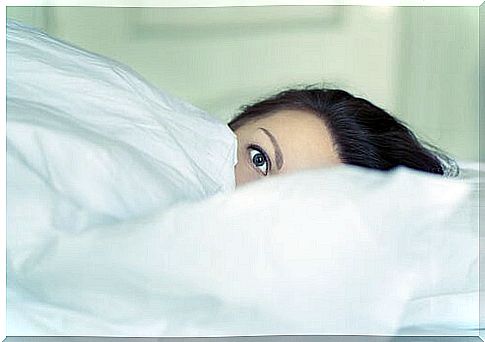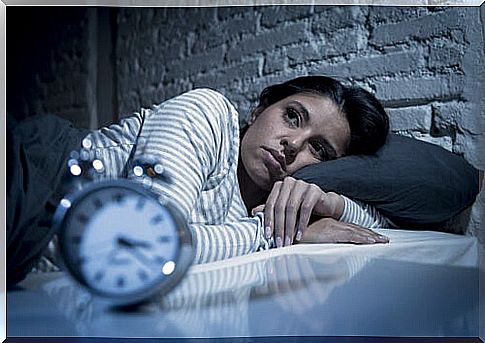Hypnomania, What’s Behind The Obsession With Sleep?

Sleep disorders are frequent in the population and, specifically, insomnia is the most frequent of them. About a third of the population reports having insomnia problems. Among the possible causes are hypnomania or the obsession to sleep, although this can also be a consequence of insomnia itself. Later we will see how this vicious circle is formed.
According to the Spanish Society of Neurology, between 20 and 48% of the Spanish adult population suffers from difficulty initiating or maintaining sleep. This is important since the obsession with sleep can also be the cause of other sleep disorders, such as excessive daytime sleepiness or hypersomnia, and other mental disorders, such as depression.
Throughout the article we will learn more about this condition, its symptoms, causes and treatment, and the possible relationship with other psychological and physical problems.

What is hypnomania and how to differentiate it from other similar conditions
The name hypnomania comes from the union of two Latin words: hypnos, which means ‘dream’; and mania , which means ‘madness’. This term refers to the intense and uncontrollable desire to sleep, to the constant need to sleep, to the point of becoming an obsession.
This desire can be independent of the number of hours slept and the feeling of sleep when waking up, although many times it is related to problems such as insomnia. It is important to differentiate hypnomania from other similar terms, such as clinomania, narcolepsy, or hypersomnia.
Clinomania refers to the desire or obsession to constantly lie down. We should not confuse it with the classic “five more minutes” that follows the sound of the alarm. Clinomania implies the complete abandonment of other daily activities in order to remain in bed, but not necessarily sleeping.
Hypersomnia refers to the presence of excessive sleepiness after having had enough sleep, at least seven hours, and does not refer only to the amount of sleep, but the person who suffers from it may even have problems to remain fully awake after waking up.
Narcolepsy, for its part, is an organic (not mental) disorder in which there is an irrepressible need to sleep. This is accompanied by periods of cataplexy in which muscle tone is suddenly lost, hypocretin deficiency (also called orexin) and shortened REM sleep latency (less than or equal to 15 minutes).
Causes and consequences of hypnomania
Hypnomania can be both the cause and the consequence of other disorders and may even be masking others. Insomnia can be the origin of hypnomania because the reduction in the quality and quantity of sleep leads to an obsession to sleep more.
And what is the problem? That one’s obsession with getting more sleep may be what causes insomnia. In this way, a vicious circle is created in which both factors feed off each other.
In the case of hypersomnia, the fact that you are constantly thinking about the need to sleep (due to the belief that you have not had enough sleep) can cause drowsiness to appear, even without being sleepy. This drowsiness can cause that we are not able to maintain the level of alert and our performance is greatly diminished.
In addition, we can find another added problem: going to bed without sleep will make us spend hours in bed believing that we are sleepy, but without being able to reconcile it, resulting in the feeling or belief of having insomnia.
On the other hand, hypnomania may be masking a bigger problem. People with depression can spend the entire day thinking about when to get to bed, since it is the moment when the day ends and they can stop thinking and suffering.
Usually, melancholic depression is accompanied by problems falling asleep and early awakening. However, in the case of depression with atypical characteristics, the predominant sleep problem is hypersomnia.
In case of suspicion of hypnomania, it is necessary to verify that the rest of the diagnostic criteria for depressive disorders are not also met, in order to make an adequate differential diagnosis and choose the most effective treatment.
Possible treatments
In the first place, in order to find an adequate treatment, it is necessary to make a correct evaluation to verify that hypnomania is not a consequence of a greater problem. Likewise, it is necessary to carry out an adequate functional analysis to know the antecedents and consequences of the problem.
If, after evaluation, it is concluded that hypnomania is related to an insomnia disorder, different interventions may be performed to treat the insomnia. It is necessary to intervene on this, since it may be the origin of the problem, so that, if it is possible to increase the number of hours of sleep or its quality, it will be possible to reduce the obsession with sleep. They can be used:
- Progressive muscle relaxation techniques or autogenic training, to relax the body.
- Stimulus control techniques: instructions to reduce behaviors incompatible with sleep and to regulate the schedule.
- Sleep hygiene guidelines: habits that facilitate sleep.
- Sleep restriction, to limit the number of hours spent in bed while awake.
- Paradoxical intention: widely used to interrupt preoccupation with insomnia.
When hypnomania is both a cause and a consequence of insomnia, this last technique is very useful. In these cases, the fact of sleeping little or badly generates the thought “I need to sleep more”, becoming an obsession. This obsession is, in turn, the one that prevents normal sleep. Paradoxical intention is used to break this vicious circle.
This technique consists of asking the person to spend as much time as possible in bed awake. By changing the brain from the command “you have to sleep” to “you have to be awake”, the need to sleep is no longer an obsession and attention is stopped and, as a result, the person is able to sleep.

How the brain plays us
The relationship between hypnomania and insomnia is a clear example of how the brain sabotages us. Worrying is fine and can allow us to find the solution to a problem, but worrying too much can exacerbate the problem. It is as if our brain has a “tolerable worry threshold” and, when we exceed it, we lose the ability to solve the problem, even when we have the solution within our reach.
We give so much prominence to worrying about sleeping less than normal, that we are the ones who end up turning it into a disorder. This is not to convey the idea that there is no need to worry about sleeping habits, but rather that it is necessary to worry in a useful and constructive way, avoiding that worry itself takes away our sleep.









